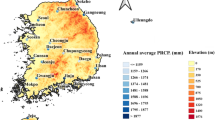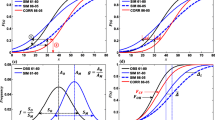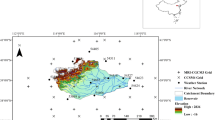Abstract
The frequency and magnitude of water-related disasters such as floods and landslides have intensified due to climate change, especially over East Asia, including the South Korea region. In this region, extreme precipitation events originate from multiple sources, such as tropical cyclones (i.e., typhoons) and frontal synoptic systems. Climate scenarios generated by global climate models (GCMs) are employed to assess the future variations of extreme precipitation. Precipitation outputs from GCM scenarios must be localized via dynamic downscaling through regional climate models (RCMs). Bias correction is required to eliminate the biases between the RCM outputs and local observations. Quantile mapping, in which RCM output values are mapped by quantiles onto historical observed data of all precipitation except zero values by fitting a probabilistic distribution to each dataset, has been a popular technique for bias correction. In the current study, we tested several probabilistic distribution models. Additionally, we tested several mixture probabilistic distributions, combinations of traditionally employed distributions, because extreme precipitation events over South Korea can develop from multiple weather systems. We also tested traditionally employed distributions, such as exponential, gamma, and GEV distributions for precipitation values except zero values. Their performances were evaluated with various statistics, especially for extreme events, because the bias-corrected data should be used for the assessment of future variations of extreme precipitation. The results indicate that the tested mixture distributions are superior to traditional non-mixture distributions. The gamma-Gumbel mixture distribution showed the best performance in reproducing the statistical characteristics of especially extreme precipitation in a way that the majority of non-severe precipitation events are fitted to the gamma distribution, whose tail is light, and the extreme events are fitted to the Gumbel distribution. The future variations of extreme precipitation from climate scenarios such as RCP 4.5 and RCP 8.5 showed clear differences between probabilistic distribution models, indicating that the selection of an appropriate distribution is critical in the reasonable assessment of future extreme precipitation.













Similar content being viewed by others
References
Alexandrov VA, Hoogenboom G (2000) The impact of climate variability and change on crop yield in Bulgaria. Agric For Meteorol 104:315–327
Alia OM, Mandava R (2011) The variants of the harmony search algorithm: an overview. Artif Intell Rev 36:49–68
Beck A, Ahrens B, Stadlbacher K (2004) Impact of nesting strategies in dynamical downscaling of reanalysis data. Geophys Res Lett 31:5. https://doi.org/10.1029/2004GL020115
Carreau J, Naveau P, Sauquet E (2009) Water Resour Res 45:n/a-n/a
Davies T, Cullen MJP, Malcolm AJ, Mawson MH, Staniforth A, White AA, Wood N (2005) A new dynamical core for the Met Office’s global and regional modelling of the atmosphere. Q J R Meteorol Soc 131:1759–1782
Denis B, Laprise R, Caya D, Côté J (2002) Clim Dyn 18:627–646
Déqué M (2007) Frequency of precipitation and temperature extremes over France in an anthropogenic scenario: model results and statistical correction according to observed values. Glob Planet Chang 57:16–26
Evin G, Merleau J, Perreault L (2011) Two-component mixtures of normal, gamma, and Gumbel distributions for hydrological applications. Water Resour Res 47(8):W08525
Geem ZW, Kim JH, Loganathan GV (2001) A new heuristic optimization algorithm: harmony search. Simulation 76:60–68
Giorgi F, Mearns LO (1999) Introduction to special section: regional climate modeling revisited. J Geophys Res: Atmospheres 104:6335–6352
Goldberg DE (1989) Genetic algorithms in search, optimization, and machine learning. Addison-Wesley Pub. Co., Boston
Gudmundsson L, Bremnes JB, Haugen JE, Engen-Skaugen T (2012) Technical Note: downscaling RCM precipitation to the station scale using statistical transformations – a comparison of methods. Hydrol Earth Syst Sci 16:3383–3390
Gutjahr O, Heinemann G (2013) Comparing precipitation bias correction methods for high-resolution regional climate simulations using COSMO-CLM. Theor Appl Climatol 114:511–529
Haddeland I, Heinke J, Voß F, Eisner S, Chen C, Hagemann S, Ludwig F (2012) Effects of climate model radiation, humidity and wind estimates on hydrological simulations. Hydrol Earth Syst Sci 16:305–318
Hagemann S, Chen C, Haerter JO, Heinke J, Gerten D, Piani C (2011) Impact of a statistical bias correction on the projected hydrological changes obtained from three GCMs and two hydrology models. J Hydrometeorol 12:556–578
Hansen JW, Challinor A, Ines A, Wheeler T, Moron V (2006) Translating climate forecasts into agricultural terms: advances and challenges. Clim Res 33:27–41
Hempel S, Frieler K, Warszawski L, Schewe J, Piontek F (2013) A trend-preserving bias correction – the ISI-MIP approach. Earth Syst Dynam 4:219–236
IPCC, Pachauri RK, Reisinger A (eds) (2007) Climate change 2007: synthesis report. Contribution of Working Group I, II and III to the Fouth Assessment Report of the Intergonernmental Pallel on Climate Change, IPCC. Geneva, Switzerland; 104
Jeong C, Lee T (2015) Copula-based modeling and stochastic simulation of seasonal intermittent streamflows for arid regions. J Hydro Environ Res 9:604–613
Katz RW, Zheng X (1999) Mixture Model For Overdispersion of Precipitation. J Clim 12:2528–2537
Kennedy J, Eberhart R (1995) Particle swarm optimization. Perth, Aust, 1995. IEEE
Kilsby CG, Cowpertwait PSP, O'Connell PE, Jones PD (1998) Predicting rainfall statistics in England and Wales using atmospheric circulation variables. Int J Climatol 18:523–539
Leander R, Buishand TA (2007) Resampling of regional climate model output for the simulation of extreme river flows. J Hydrol 332:487–496
Lee T (2016) Stochastic simulation of precipitation data for preserving key statistics in their original domain and application to climate change analysis. Theor Appl Climatol 124:91–102
Lee T, Jeong C (2014) Nonparametric statistical temporal downscaling of daily precipitation to hourly precipitation and implications for climate change scenarios. J Hydrol 510:182–196
Lee T, Ouarda TBMJ, Jeong C (2012) Nonparametric multivariate weather generator and an extreme value theory for bandwidth selection. J Hydrol 452-453:161–171
Lettenmaier D, Wood A, Palmer R, Wood E, Stakhiv E (1999) Clim Chang 43:537–579
Martin GM, Ringer MA, Pope VD, Jones A, Dearden C, Hinton TJ (2006) The physical properties of the atmosphere in the New Hadley Centre Global Environmental Model (HadGEM1). Part I: model description and global climatology. J Clim 19:1274–1301
Mehrotra R, Sharma A (2006) Conditional resampling of hydrologic time series using multiple predictor variables: A K-nearest neighbour approach. Adv Water Resour 29:987–999
Panofsky HA, Brier GW (1968) Some applications of statistics to meteorology, Earth and Mineral Sciences Continuing Education, College of Earth and Mineral Sciences
Park JS, Jung HS (2002) Modelling Korean extreme rainfall using a Kappa distribution and maximum likelihood estimate. Theor Appl Climatol 72:55–64
Piani C, Haerter JO, Coppola E (2010) Statistical bias correction for daily precipitation in regional climate models over Europe. Theor Appl Climatol 99:187–192
Schmidli J, Frei C, Vidale PL (2006) Downscaling from GCM precipitation: a benchmark for dynamical and statistical downscaling methods. Int J Climatol 26:679–689
Sharma D, Das Gupta A, Babel MS (2007) Spatial disaggregation of bias-corrected GCM precipitation for improved hydrologic simulation: Ping River Basin, Thailand. Hydrol Earth Syst Sci 11:1373–1390
Shin J-Y, Heo J-H, Jeong C, Lee T (2014) Meta-heuristic maximum likelihood parameter estimation of the mixture normal distribution for hydro-meteorological variables. Stoch Env Res Risk A 28:347–358
Shin J-Y, Lee T, Ouarda TBMJ (2015) Heterogeneous mixture distributions for modeling multisource extreme rainfalls*. J Hydrometeorol 16:2639–2657
Strupczewski WG, Kochanek K, Bogdanowicz E, Markiewicz I (2012) On seasonal approach to flood frequency modelling. Part I: two-component distribution revisited. Hydrol Process 26:705–716
Teutschbein C, Seibert J (2012) J Hydrol 456–457:12–29
Themeßl MJ, Gobiet A, Leuprecht A (2011) Empirical-statistical downscaling and error correction of daily precipitation from regional climate models. Int J Climatol 31:1530–1544
van Pelt SC, Beersma JJ, Buishand TA, van den Hurk BJJM, Kabat P (2012) Future changes in extreme precipitation in the Rhine basin based on global and regional climate model simulations. Hydrol Earth Syst Sci 16:4517–4530
Widmann M, Bretherton CS, Salathé EP (2003) Statistical precipitation downscaling over the Northwestern United States using numerically simulated precipitation as a predictor*. J Clim 16:799–816
Wood AW, Leung LR, Sridhar V, Lettenmaier DP (2004) Hydrologic implications of dynamical and statistical approaches to downscaling climate model outputs. Clim Chang 62:189–216
Yoo C, Jung K-S, Kim T-W (2005) Rainfall frequency analysis using a mixed gamma distribution: evaluation of the global warming effect on daily rainfall. Hydrol Process 19:3851–3861
Yoon P-Y, Kim T-W, Yang J-S, Lee S-O (2012) Estimating quantiles of extreme rainfall using a mixed Gumbel distribution model. J Korea Water Resour Assoc 45:263–274
Yoon S, Jeong C, Lee T (2013) Application of harmony search to design storm estimation from probability distribution models. J Appl Math. https://doi.org/10.1155/2013/932943
Funding
This research was supported by a grant [MOIS-DP-2015-03] through the Disaster and Safety Management Institute funded by Ministry of the Interior and Safety of Korean government. The authors also acknowledge that this work was partially supported by the National Research Foundation of Korea (NRF), Grant (2018R1A2B600179), funded by the Korean Government.
Author information
Authors and Affiliations
Corresponding author
Rights and permissions
About this article
Cite this article
Shin, JY., Lee, T., Park, T. et al. Bias correction of RCM outputs using mixture distributions under multiple extreme weather influences. Theor Appl Climatol 137, 201–216 (2019). https://doi.org/10.1007/s00704-018-2585-3
Received:
Accepted:
Published:
Issue Date:
DOI: https://doi.org/10.1007/s00704-018-2585-3




